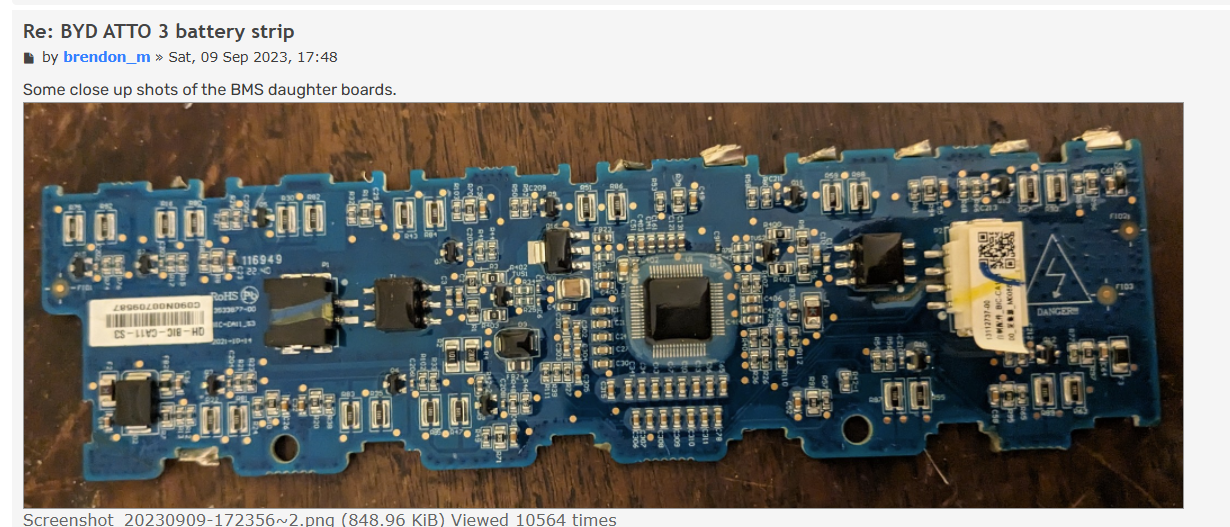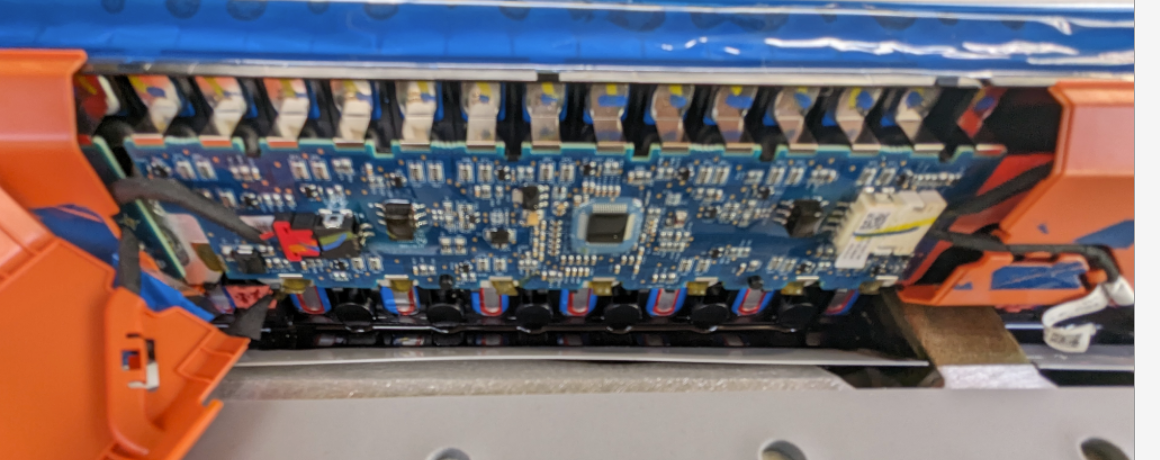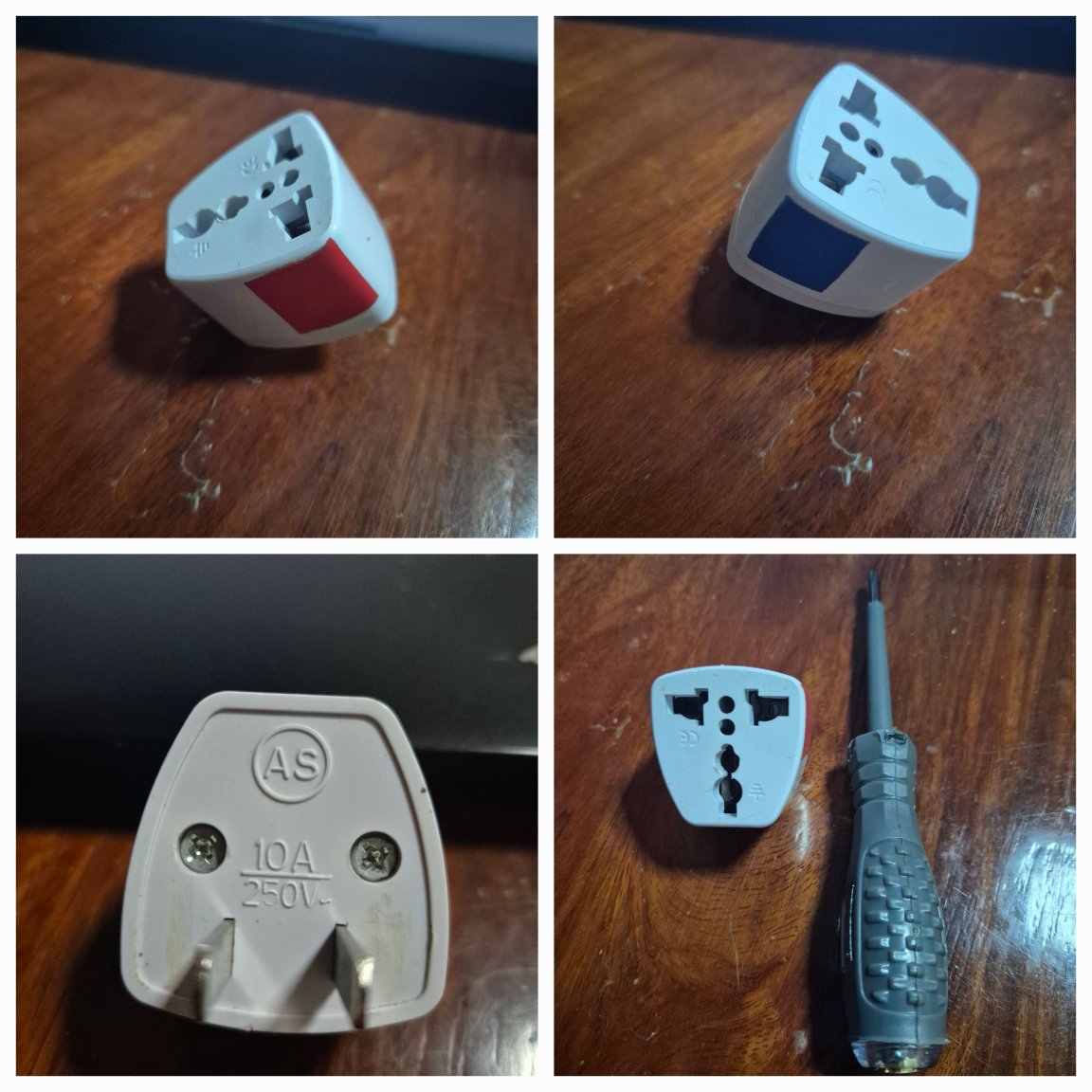-
Posts
29,074 -
Joined
-
Last visited
Content Type
Events
Forums
Downloads
Quizzes
Gallery
Blogs
Everything posted by Pib
-
Leaving USA ? Be aware of 30% tax....
Pib replied to GypsyT's topic in US & Canada Topics and Events
Typical talk after an election....if the Democrats won many rightists say they are leaving the U.S.....if the Republicans won many leftists say are leaving the U.S. -
EV Owners … Real life experience & help thread
Pib replied to KhunLA's topic in Thailand Motor Discussion
And just to supplement my above post I think the BYD passive balancing daughter boards are basically larger versions of the resistive balancing board talked below at around 13:52 into the video. I will also add where I mentioned in my earlier post a brief cell balance of around 250mv just before hitting 100% while charging but it quickly goes back to around 7mv, that 250mv brief imbalance is mostly "surface charge" which contains very, very little capacity and is quickly consumed under normal battery load. Same thing happens when you fully charge a good ol' 12V lead acid battery and then immdiately check the voltage which is probably going to be a little over 13 volts...maybe even around 13.5 vs the nominal voltage of around 12.6 to 12.8V. Turn the headlights on for 15 seconds or so and the battery's surface charge will get consumed very quickly and then the measured voltage with headlights off will now be around 12.6 to 12.8V. -
Leaving USA ? Be aware of 30% tax....
Pib replied to GypsyT's topic in US & Canada Topics and Events
As Jingthing already pointed non-U.S. citizens can receive social security....many, many do. They just need to have worked/resided in the U.S. for the required number of years. Heck even a non-U.S. citizen spouse who lived in the U.S. for at least 5 years with their US citizen spouse can get a spousal social security pension even if the non-U.S. citizen never worked/paid social security taxes. The law has been that way for many years. -
EV Owners … Real life experience & help thread
Pib replied to KhunLA's topic in Thailand Motor Discussion
I've been interested over the last month regarding how my BYD Atto 3 LFP 60.5KWH battery is designed for cell balancing. It has 126 cells with each cell being a 152AH cell. Below is a snapshot/partial quote from the website from a guy who bought a wrecked Atto 3 just to get the traction battery which was undamaged, disassembled the battery as much as possible, and converted it to a home solar battery storage pack. Below are some snapshots of one of the BMS daughter boards (10 total such daughter boards plus a motherboard in the front of battery) which indicates it uses passive resistor balancing where two 10 ohm resistors in series for each cell along with a BJT transistor/MOSFET are used for balancing---classic components for a BMS that uses passive resistor balancing. So on any motherboard that manages 14 cells you'll count 28 ten ohm resistors on heat dissipation pads and 14 nearby MOSFETs along with other components. You will also notice no bank of inductors (like 14 inductors instead of 14 resistors), capacitors (like 14 capacitors instead of 14 resistors), or a transformer on the daughter boards which would indicate "active balancing." And this passive balancing works really well according to OBD2 data on my Atto. I've monitored the Cell Voltage Delta/Balance for weeks now....it's typically has a cell balance/delta of only 7 millivolts while idling, driving steadily, and charging although at around 99% charged while charging the cell balance will go to approx 250mv briefly, but after charging completes at 100% charge the balance quickly returns to approx 7mv after just a couple kilometers/around 10 minutes of driving....when reaching approx 99.5% charge level. I expect the BYD Dolphin and Seal (and similar BYD BEVs) use the same passive balancing approach. https://forums.aeva.asn.au/viewtopic.php?t=8323 Snapshots of an BMS daughter board from an Atto battery. The cells have BMS boards covering the terminals down the right side (drivers side in RHD countries). The boards span 12 and 14 sets of cells (3x 14s boards and 7x 12s boards) and appear to be powered from the cells themselves as there are only 2 data wires coming out of the contactor block at the front and linking each board in a daisy chain fashion. Each board also has a temperature probe going into the cells. The lower edge of the board has the inputs from the busbars and they get passed through to the upper edge. This is along circuit tracks on the underside of the board. Then there are vias that take the traces through to the top of the board to all the balancing guff. The balancing guff consists of a transistor and 2x 10 Ohm resistors in series with each other. The upper edge of the board has the inputs from the terminals on the cells that go to the other side of the pack. Strangely enough it also has nickel strips that link the near side busbars to the other side of the pack. But then they aren't connected to anything. -
The wife and I did our DLT eLearning training a few months ago to renew our license. From looking at the QR code certificates I saved on my phone per Google Translate at the top it says in black letters "Please save to display this QR code on the day of service at the transportation office". Then it has the QR code and also a long long reference code beneath the code. Then it has what ID number like Thai ID card, Pink ID card, or Passport that you used. Then it says: "Trained. Renew personal car driving license" Then is shows the training date. And finally at the bottom in red text is says: "*Training results are valid for 6 months from date of training"
-
Leaving USA ? Be aware of 30% tax....
Pib replied to GypsyT's topic in US & Canada Topics and Events
Below provides more details....nothing new about this....it only applies when a person meets the right conditions. https://www.gfp.institute/post/how-the-us-exit-tax-is-calculated-for-covered-expatriates -
Just installed the iGreen charging network app. No need to register to see their charging locations and number of chargers at each location. iGreen chargers are predominately in the greater Bangkok area. When using the app to show/filter AC "and" DC charging "locations" it gives a total of 161 locations. But when selecting to show locations with AC chargers it lists 157 locations. So the great majority of the 161 locations have AC chargers but they may also have DC chargers. When selecting show me DC chargers it lists 59 locations out of the 161 locations. So, I guess that means of the 161 locations iGreen has AC and/or DC chargers but of those 161 locations only 59 of them have DC chargers with the great majority those DC charging locations being in the greater Bangkok area. 4 DC charging locations in the Chonburi/Pattaya area....3 DC charging locations in the Chiang Mai area....and then just a few more DC charging location in a few other areas. Now I've been talking "locations".....each location has multiple AC and/or DC chargers totaling up to hundreds of chargers....maybe approaching approx 500 chargers across the 161 locations. Some locations have 2 DC chargers and 3 AC chargers. Where I mentioned in my other post I first notice iGreen chargers at the Foodland I go to in Bangkok, well, that location has 2 AC chargers and 2 DC chargers. It looks like the only payment option is debit/credit card....don't know if it only accepts "Thai" debit/credit cards or foreign cards also. The card is used to top-up your iGreen wallet...then payment for each charging session is deducted from the iGreen wallet. So if you want to start a charging session you will need to use your card to top-up your iGreen wallet. Still thinking if I want to register. Since the great majority of their DC chargers are in the greater Bangkok area where I live that doesn't do "me" much good for long trips away from home. But for someone who say lives a couple hundred kilometers outside of Bangkok and will be making frequent trips to Bangkok then that would be a good thing for them recharging-wise. Each person is different as to where they need/want to see DC chargers.
-
I registered with below charging networks since they are the top 6 in terms of number of DC chargers. And I have used all of them mostly for testing purposes...ensure they "really" work for me....get use to using each one. They all operate pretty close the same way...just minor differences. Now I have used the ReverSharger network around 50 times since early August as I can charge for free thru 2 Jan 2025...so, I stop and top-up often in my day-to-day....get as many free electrons as I can while they are free. Charging Apps I'm Registered With - PTT EV Station Pluz - PEA Volta - EA Anywhere - Elexa - Altervim - ReverSharger More and more PTT stations seem to be adding chargers and lord knows PTT stations are almost everywhere on main roads. And it not uncommon for a some PTT stations to have charger but they will not have an EV emblem on their big road sign. ALWAYS use the charging apps to see where their chargers are...do not expect there to be some big neon sign along the road saying there is a charger at this location----use the apps.....lots of chargers in many locations. Sure, some Thailand locations have few public chargers (especially rural areas) but for long trips via main roads there is enough DC chargers to get to where you are going. I rarely have a need to use a DC charger since I have a wall charger and my Atto has a real world range of 400-440Km (BYD advertised NEDC range of 480Km or WLTP 420Km). It's not like I'm doing daily/weekly Bangkok-Pattaya road trips....the great, great, great bulk of my driving does not exceed a 150Km "radius." With that 400-440Km real-world range I can drive around a 200km "radius" from my home without needing to recharge if I wanted to run down close to 0% charge before getting back home...but I'm not that stupid. ...when on a long trip I always plan a recharge/top-up to ensure I have at least 25% remaining when getting home/going to whatever location I'm going to. And I will stop and charge for say 20 minutes while me and the wife take a bathroom break, grab a snack/bit to eat, etc....I may have zero need to charge while making that bathroom stop but since there is a DC charger there why not do a top-up...not necessarily to 100%...maybe just do 20 minutes of charging. After 13 months of driving my Atto the little bit of range anxiety I initially had has long disappeared because of so many places for me to charge,,,and because of the range of my Atto. And heck, people driving around in BEVs which have around a 600Km range probably laugh when someone says "range anxiety." For the charging apps that require a debit/credit card for payment only the ReverSharger app would not accept my Bangkok Bank Mastercard debit card, but gladly accepted my foreign credit card. Some apps don't even require a credit card as they offer the QR payment method.....some offer debit/credit card and QR payment....and some use the Wallet approach where you put money in the app's wallet via top-up from debit/credit card or QR payment. Whatever app you register with be sure to determine what "payment option(s) they offer....don't do much good to be able to register but can't add a payment option....if you don't have a payment option that you can use then you will not be able to use the app to charge the EV. P.S. When at a small Bangkok mall the other day where the Foodland is that I primarily go to once or twice a week they just finished installing some "iGreen" DC and AC chargers. A new charging company not listed on above chart....new charging companies popping up all the time. I'll probably install their app to see if they are worth signing up with....see their website below with links for app download/install. https://igreenplus.co.th/
-
Onion chargers have been around for a while....they are mostly Level 2, 7KW or 22KW "AC" chargers....Onion has few DC Chargers. I see them periodically in malls here in Bangkok like at Central Malls. https://evat.or.th/ev-information/current-status/index
-
And below is my poorly made and very short video of above homemade "pass-thru bonded neutral-ground adapter" charging my Atto. Please note I have already used my voltage detector screwdriver to determine which is the hot/live hole and neutral hole on my carport socket (A VERY IMPORTANT, MUST DO STEP)....the top hole on the socket is the hot/live hole and bottom hole the neutral....and then I plug-in the 2 prong pass-thru adapter in the correct hot/live and neutral orientation. The charger's power light comes on steady and the charging light begins blinking which means it's charging since I already have the CCS cable connected to the Atto charging port. And the Fault light being off means no fault detected like it detecting it doesn't see any ground since it is seeing a ground due to the pass-thru connector. Since the neutral and ground connectors within the adapter are wired together the portable adapter sees a ground and the charger is happy....it begins charging. If you just plugged the charger's cable into a socket with only 2 wires (hot and neutral) without the pass-thru adapter the charger does not see an earth connections and its the Fault light comes on and it does "not" begin charging. With this BYD portable 10A charger it charges the Atto at a 1.8KWH to 2.2KWH rate depending on the current charge level of your EV. One hour of charging will give approx 3 to 4% charge....10 hours 30 to 40%, etc. This is info only....don't attempt this unless you understand the neutral-ground bonding concept and comfortable working with electrical circuits like 220V circuits. Lots or Youtube video and many webpages talking pass-thru bonded neutral-ground adapter construction (very simple construction) and how to use. The adapter comes in very hand in the land of 2 wire socket when needing to plug-in a 3 wire device expecting to see a ground connection. Or as others have done buy a 2 wire portable charger that doesn't use/need an ground connection. 20241110_123736.mp4
-
Here's a trend. On my Bangkok moobaan soi there are 10 houses/families. 4 of the 10 now have BEVs. But around a year and half ago 0 of 10 houses had BEVs. Around 16 months ago one house got a Tesla Model Y....then around 14 months ago another house got a BYD Atto .....then about 13 months another house (mine) got a BYD Atto ....and over the last few weeks another house now has a white Neta X. All 4 houses have EV wall chargers installed.
-
To get that extra 174 to reach 4,954 is not a big number at all. Heck in my post a few hours ago (partial quote below I found 123 of the 174 by briefly sorting thru the DLT spreadsheet I mentioned earlier. I just quickly looked at some of the most well known BEV brands like Aion, Deepal, BYD, and MG. I stopped looking at that point....I'm sure if I had kept looking at some more brands I would have found all 174.....those 174 that DLT had listed other than RY1 but Autolife tossed them into RY1 chart. - a
-
Keep in mind these portable chargers will only add about 3% charger per hour. That would be like 30% over 10 hours...like if you charged overnight. For a Dolphin with 410km range a 30% charge would be around 123km of driving...or let's say probably more like a little of 100km. But that may be more than an adequate daily top-up charge for typical daily driving, to get down the road where there are plenty of DC Fast Chargers. My portable charger easily met my daily driving needs when I first go my BYD Atto but didn't get the wall charger installed for several weeks later...I just didn't need to use a DC charger. Topping-up by 30% over 10 hours was more than enough to keep me fully charged up...and actually after about 6pm everyday I didn't need to use the Atto until around 10am to 11am the next day so I got enough time to do around 16-17 hours of charging everyday if needed which is -approx 50%/around 200-220km realworld worth of charge/mileage for my Atto.
-
Here's that special adapter more formally called a "pass-thru bonded neutral-ground adapter." Lot's of Youtube videos on this type of adapter by those folks who use certain types of portable generators. Fancy name to where the neutral and ground are connected together within the adapter. Also the screwdriver shown is one of those "voltage detector" screw drivers which lights up when touching 110V/220V. I keep them with in my portable charger carrying case for possible use in the land of two wire (hot and neutral) outlets. Outlets that may have three holes (hot, neutral & ground) but actually there is no ground wire hooked to the outlet. I've also wrote myself a note I keep with this "pass-three bonded neutral-ground adapter" that goes along the lines of saying: This is a pass-thru bonded neutral-ground adapter. The hot/live prong side is marked with Red tape must only be plugged into the hot/live hole on a 2 wire socket. Otherwise, 220V will be applied to the ground prong/hole. Use voltage detector to determine hot/live and neutral on the 2 wire socket before plugging in the adapter. This is info only....don't attempt this unless you understand the neutral-ground bonding concept and comfortable working with electrical circuits like 220V circuits.
-
Yea...if you want to be super, super accurate to ensure any double counting is compensated for to several decimal points and the BEV percentage is reported by multiple categories. But if willing to allow a small inaccuracy by allowing some 4 wheel BEVs carrying 7 passengers or less to be counted as RY1 as the Autolife chart does probably for ease of reading and avoid having an overly complicated chart which shows how many 7 passenger or less BEV vehicles are being registered then in my opinion the Autolife chart is fine. Totally accurate--No; but acceptable accuracy in order to provide an easy to read/understandable chart for the layman. Now assuming BEV numbers continue to increase at some point that double counting talked above will create too big of an inaccuracy even for the layman, but I expect Autolife will switch to reporting such stats in a different way....and probably stop reporting any type of detailed BEV stats like how they report on the various models. Time will tell.
-
No....you are considering too many of the categories. Like where you said for October the DLT stats showed 4,780 BEVs sold in RY1; but the Autoife article/chart showed 4.954 for a difference of 174. That 174 is just a small percentage (like 0.5%) of the total DLT RY1 numbers of 34,865 which represents EV/ICEV/Hybrid/etc., registrations. The way Autolife is treating the numbers that 174 (which is actually other categories) get counted a second time but this time as RY1 BEVs.
-
Include too many details in the article/chart would just turn-off a lot of folks...their eyes would just glaze over....they would stop reading such AutoLife articles which Autolife definitely don't want. And I'm a one thousand percent sure the great, great, great, great, great majority of folks don't look at DLT stats since they are more for the spreadsheet-comfortable type people. Yes, by throwing-in some BEV registrations dealing from some categories which also deal with vehicles that carry 7 or less passengers just like the R.Y.1 category, it does create an inaccuracy which is small at this time....make it appear R.Y.1 BEV sales are a little higher. If a person is more interested in how 4-wheel BEV registrations/sales that carry 7 or less passengers "regardless of whether its coded as DLT category RY1, RY3, RY6, RY10, etc., then the AutoLife article/chart gives a good vision of such.
-
From googling Bamnet Narong to find it on a map, it appears from looking at the PTT and PEA charging apps PTT has 3 chargers and 1 PEA charger in your general area. Your portable chargers should work fine on any 3 prong outlet that can provide at least 10 amps....but it will need to be a 3 prong type outlet....that is, have a hot line, neutral line, and earth line. If no earth line then the charger will probably error/will not charge. A lot of outlets in Thailand, while having 3 holes for a 3 prong plug do not have an earth line connected to the earth hole....instead, just a hot and neutral line are connected to the socket. However, there is a way to still use the portable charger requiring an earth line on a two hole socket (i.e., only have a hot and neutral connection) but it's a little technical.
-
From review of one of the DLT stat spreadsheets where a person can sort/display by month, brand, fuel type, etc., it indicates that Autolife probably also counts BEV/100% electric vehicles from some other vehicles categories other than R.Y.1 which contains the great bulk of BEV registrations. It appears Autolife also counts BEV/100% electric vehicles R.Y.3 Personal Truck, R.Y.6 Passenger Vehicle for Hire Not Carrying More Than 7 People, R.Y.10 Sight Seeing Vehicles, etc., However, Autolife does "not" mention their monthly article/chart can also include these other categories if the BEV vehicle is being used to transport no more than 7 passengers and basically a company is using the BEV just like a private person would use their BEV to transport their family/friends as passengers. For example below (but not limited to) some BEVs "not" listed as R.Y.1 by DLT but as another vehicle category. I bet Autolife counted them as R.Y.1. Autolife probably don't want to confuse readers by stating what categories of BEV/100% electric vehicles were actually listed in by DLT which can be around 20 different categories a vehicle can be coded as. Instead their article/chart just mentions R.Y.1 where the great, great, great majority of current BEV/100% electric vehicles end-up being coded in. - 16 BYD BEVs listed by DLT in category R.Y.3 - 1 Aion BEV listed by DLT in category R.Y.6 - 3 Changan Deepal BEV listed by DLT in R.Y.3 - 100 MG BEV listed by DLT in category R.Y.6 (registered in Bangkok and Phuket provinces most likely by rental/tourist companies) and 3 more MG BEV in category R.Y.10 In closing, assuming Autolife is also counting some non-R.Y.1 BEVs which carry 7 or less passengers for business purposes (like sight seeing, rental) and if we really want to know how many BEV/100 electric cars/trucks using 4 wheels and carrying 7 passengers or less, then the Autolife stats/chart is really more accurate in my opinion in how well BEVs are selling. Autolife's BEV R.Y.1 numbers will always be a little higher than DLT BEV R.Y.1 numbers since Autolife is really counting some BEVs from some other categories also.
-
I expect it was a "legal" issue regarding vehicle information server ownership versus a technical issue. And as usual money took care of that legal issue and/or reaching a new agreement regarding server information ownership. https://insideevs.com/news/736798/fisker-ocean-data-impossible-port/
-
Above relates to using the Fisker smartphone app to turn off and on the A/C or lock/unlock the car using the app like you want to do such from a distance like from inside your residence, etc. But the app is "not" needed to turn on/off the A/C or lock/unlock the car as long as you physically go to the car...use the key FOB to lock/unlock doors, start the car, start the A/C, etc. Or just turn on/off the A/C while setting in the car. The BYD app works the same way. I didn't even use the app for the first two months I had my Atto EV....then I decided to install/start using it. It's nice feature to check if the doors/windows are locked/closed, check tire pressure, check traction battery charge level, odometer reading, turn on the A/C to let the car cool down for a few minutes before you go to the car, and do a couple other things. But the app is "not" needed to drive the car, operate the A/C, etc.; it's only a nice convenience. And for the BYD app you can still use it to control/monitor certain functions on the car even when you turn off Cellular Data and/or Wifi connection as the the app uses the call/messaging capability of the mobile network versus mobile data/Wifi. If a person wants to go dark from BYD servers or anybody monitoring/controlling the EV from the cloud they need to remove the EV's SIM which in the Atto is on the left side of the center console. The EV will still run just fine without the SIM,,,,it's just the BYD servers can't monitor/talk to the car anymore, you can't connect with BYD app, etc.
-
Thanks....some interesting stuff in the first weblink you provided....the electrek.co link. I pasted some partial quotes below regarding BYD, Tesla, Honda and good ol' Toyota. Also a link at the very bottom talking "How Toyota sneakily spreads anti-EV propaganda in Japan" How Toyota sneakily spreads anti-EV propaganda in Japan https://electrek.co/2021/11/11/how-toyota-sneakily-spreads-anti-ev-propaganda-in-japan/
-
None of them as I don't like the exterior look of any of them. Too boxy looking....and don't like the HUGE front-end grille. But hey, that's just my personal taste....I know MANY people love the HUGE front grille look which is fine.
-
Form 7162 Anybody Received Theirs Yet for 2024?
Pib replied to John Drake's topic in US & Canada Topics and Events
I just noticed you received the early Jun first mailing o/a 23 Oct...obviously got delayed big time in the US/Thailand mailing systems....moved like a tortoise...got hung-up somewhere. But you received the late Oct 24 Oct second mailing o/a 4 Nov....obviously that mailing zipped thru the US/Thailand mailing systems....moved like a hare. Good ol' postal mail....sometimes it's like a hare....sometimes it's like a tortoise. But knock on wood (my head) after living at my Bangkok home for over a decade and half mail from the U.S. has always arrived within 9 to 14 calendar days.










